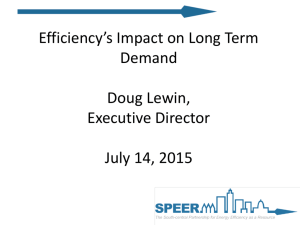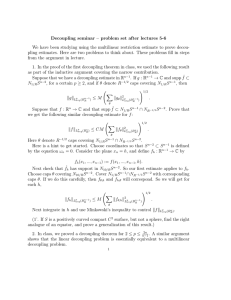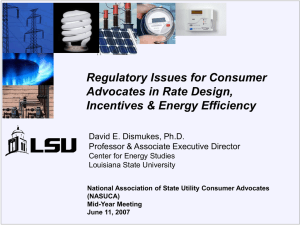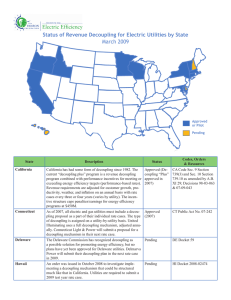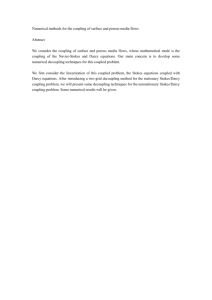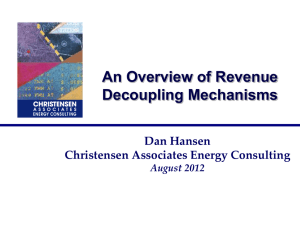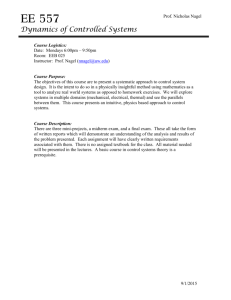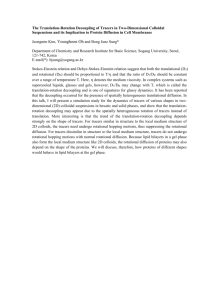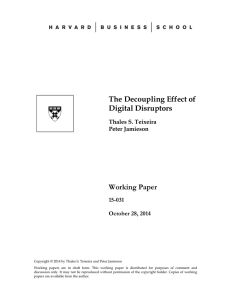Putting Decoupling into Action
advertisement
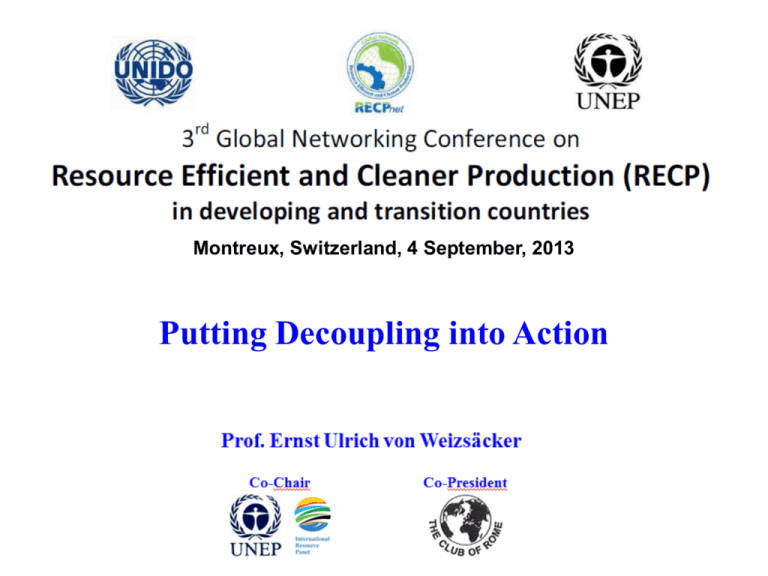
Montreux, Switzerland, 4 September, 2013 Putting Decoupling into Action UNEP‘s International Resource Panel happily acknowledges fruitful cooperation with UNIDO! Decoupling is at the core of our agenda. Our first Decoupling report (2011) documented relative decoupling for most resources. GDP grows a bit faster than resource consumption. GDP still goes with material intensity! Q: Steinberger et al, 2010 GDP per capita Our ‚Impacts‘ report showed that consumption in all sectors goes with carbon intensity: almost no decoupling Decoupling means Kuznets curves of dematerialization and decarbonization A new Decoupling Report is currently under peer review, due for publication in Autumn, 2013. It‘s going to address decoupling technologies & policies. Decoupling 2 will distinguish 1. Decoupling through maturation. 2. Decoupling through trade (burden shifting). 3. Decoupling through intentional productivity increase. 1 maturation is happening “naturally”. 2 burden shifting does not help the environment. 3 is the exception but is what we really need and is therefore the main focus of the Decoupling 2. Three areas (at least) are hopeful for decoupling efforts: Reduce greenhouse gas emissions: synergies with reducing import dependency; renewable energies enjoy sympathies; energy efficiency opportunities are huge; Reduce freshwater extraction: coincides with water purification (good for public health); can modernize farms; technologies are readily available. Waste reduction: facilitates waste management and clean cities; synergies with recycling; tends to be commercially profitable. Efficiency opportunities exist all over the place! …and more … Stunning example of absolute decoupling: water consumption in Australia. (For water extraction the situation is, of course, even better.) Source: Michael Smith et al, 2010, and Decoupling 2 Recycling rates of metals vary widely – but are often below 1%!! (Int. Resource Panel: Graedel et al, 2011) A new Report gives first answers. Lead author: Markus Reuter The Report distinguishes „big metals“: go by recycling from „spice metals“: go by design. Losses at each step, meaning also opportunities to avoid them. McKinsey speaks of huge business opportunities in energy efficiency… 2011 … more or less the same holds for material efficiency! … notably as resource prices go up. Source: McKinsey and IRP Decoupling 1 Report At he core of the answer: Taxes, tradable permits, subsidy reduction – basically equivalent in theory. In reality, what the economy likes best is predictability, which can be achieved by taxes, not by trade. Efficiency in the past was overcompensated by added consumption: The Jevons Paradox, or „rebound effect“. One condition may be a new mindset: forget about the MBA‘s, let engineers run the show. That‘s the message of Bob Lutz, the guru of Detroit. „To get the US economy growing again, we need to fire the MBA‘s and let engineers run the show“ (cf. Rana Foroohar, TIME July 18, 2011, p 16) Don‘t overestimate the role of renewable energies! If one billion people in the OECD countries achieve 20% RE‘s, only 1/35 of the world problem is solved. Developing countries NIC‘s OECD And then imagine a 35-fold increase of renewables. It‘s ecological nighmares! December 2009 March 2010 October 2010 November 2012 Think truly bold. Think of resource productivity gains by at least a Factor of Five! That’s the ambition of creating a Green Kondratiev Cycle, after five brown Cycles. Biotech IT TV, aviation, computers, Electricity, chemicals,cars Steel & railroads Mechanization Energy productivity, renew. Energy. Cyclical economy Let us run through some Factor Five examples. Volkswagen‘s concept car XL1 is five times more fuel efficient than today‘s fleet Volkswagen XL1 0.9 l/100km Today‘s fleet 5-10 l/100km Energieffizienz “Passive houses”: a factor of ten more heat efficient LED replacing incandescent bulbs: a factor of 10 Philips 7W Master LED Energy efficiency From Portland cement to geopolymer cement, e.g. fly ashes and slag; plus recycling of used concrete. Energy efficiency A little less beef, organic farming, more seasonal food … Form car-centered to human-centered cities Atlanta, Georgia Energy and space efficiency Copenhagen (above) Freiburg, Vauban (below) Ich danke Geoffrey Heal für die Überlassung des Bildes Atlanta is 25 times larger than Barcelona, with less inhabitants ! Strawberry yoghurt logistics, mad or reasonable From endless business travel to telepresence meetings Aluminium from bauxite or from scrap Energieeffizienz A few words on policies There are, of course, pollution laws, waste laws, recycling obligations, energy efficiency regulation, environmental accounting inside the firm, etc. Their impact has been good for a cleaner environment, but has not reduced the growth of energy and minerals consumption. So what can we do to reduce resource consumption? First, of course, better accounting, and stricter control of waste disposal. Then more ambitious efficiency standards. The EU Energy Efficiency Directive of 2012 and the Chinese 11th and 12th Five Year Plans are positive examples. A bold policy option at the end: Make energy and resource prices rise in proportion to the documented average efficiency increases . The idea was developed in the context of the China Council. The benign paradigm: wages rose with labour productivity, causing a ping-pong between the two. The new ping-pong will cause a steady increase, perhaps five-fold, of average resource productivity, in 40 years. To avoid social hardship and de-industrialization, two conditions should be considered: 1. Life-line tarriffs for the poor (South African model); 2. Recycle energy taxes to vulnerable industries, but not a per kilowatt-hour but per job. Thank you!
